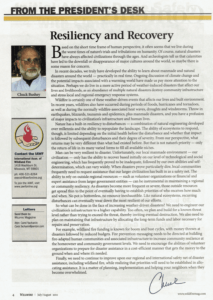One method: helping our neighbors
Resilience has been on our minds, and that’s not new. In 2011, then IAWF president Chuck Bushey focused his President’s Desk column on“Resiliency and Recovery” (Wildfire President’s Desk, July-August 2011), reminding us that …
… we need to continue to improve upon our regional and international safety net of disaster assistance, including wildland fire, while realizing that priorities will need to be established in allocating assistance. It is a matter of planning, implementation and helping our neighbors when they become overwhelmed.
His words resonate, and this issue focuses where he was leading us. Around the world, our writers help us see resilience being built on the ground.
In Arizona, we learn of a planning process that identifies fire control blocks in advance, so that communities can agree on priorities before the fire burns.
In California, we visit Modoc County (north of where the Camp Fire burned) to see a community working to unite around their fire and forest planning.
In New South Wales, we learn how post-fire research helps us improve our emergency response messages.
In the coastal plains of southeast US, we study how to expand our burning, to support our natural and human communities, and witness training crews who burn even when the US government shuts down.
In our continuing coverage of Diversity in Fire, we learn to build resilience, in ourselves and our profession, by relying on and merging our masculine and feminine firefighting frames.
Elsewhere, our writers and photographers, including current IAWF president Alen Slijepcevic and Leadership columnist Mike DeGrosky, reflect on ways to lead toward resilience in our profession, even when our work is shut down or we’re otherwise challenged by leadership hurdles.
Eight years later, join us as we carry forward Chuck’s focus on a core principle of resilience: “Helping our neighbors.”

